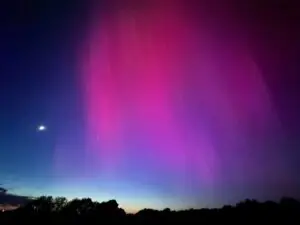 In the quiet town of Lamar, Missouri, something truly extraordinary happened recently – the night sky danced with vibrant hues
In the quiet town of Lamar, Missouri, something truly extraordinary happened recently – the night sky danced with vibrant hues 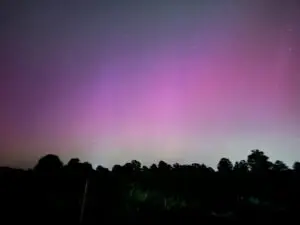 of green, purple, and pink as the mesmerizing Aurora Borealis made a rare appearance. For residents accustomed to the serene beauty of rural life, this celestial spectacle was nothing short of magical.
of green, purple, and pink as the mesmerizing Aurora Borealis made a rare appearance. For residents accustomed to the serene beauty of rural life, this celestial spectacle was nothing short of magical.
The Aurora Borealis, also known as the Northern Lights, is a natural light display predominantly seen in high-latitude regions around the Arctic and Antarctic. However, it’s not unheard of for this celestial wonder to grace more southern locales during periods of heightened solar activity, and Lamar, Missouri, found itself at the receiving end of this celestial gift.
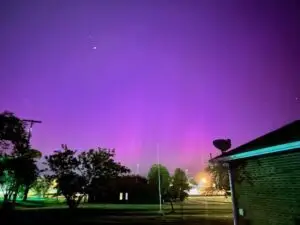 Imagine stepping outside on a crisp, clear night and being greeted by the surreal sight of luminous curtains dancing across the sky. That’s precisely what residents of Lamar experienced. Social media platforms quickly lit up with awe-inspiring images and videos capturing the ethereal beauty of the aurora as it painted the heavens with its
Imagine stepping outside on a crisp, clear night and being greeted by the surreal sight of luminous curtains dancing across the sky. That’s precisely what residents of Lamar experienced. Social media platforms quickly lit up with awe-inspiring images and videos capturing the ethereal beauty of the aurora as it painted the heavens with its 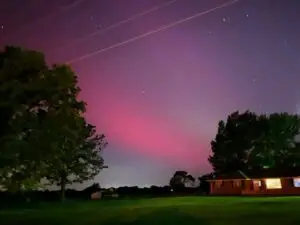 otherworldly glow.
otherworldly glow.
What causes this breathtaking phenomenon? The Aurora Borealis is a result of interactions between solar winds, charged particles from the sun, and the Earth’s magnetic field. When these charged particles collide with atoms and molecules in the Earth’s atmosphere, they emit light of varying colors, creating the stunning display we know as the Northern Lights.
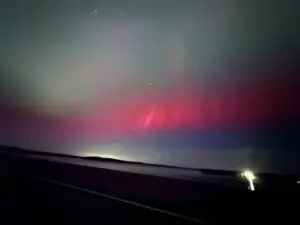 While the Northern Lights are commonly associated with regions like Alaska, Canada, and Scandinavia, their appearance in Lamar, Missouri, is a reminder of the unpredictable and wondrous nature of our universe. It’s a testament to the interconnectedness of our planet and the vastness of space beyond.
While the Northern Lights are commonly associated with regions like Alaska, Canada, and Scandinavia, their appearance in Lamar, Missouri, is a reminder of the unpredictable and wondrous nature of our universe. It’s a testament to the interconnectedness of our planet and the vastness of space beyond.
For many residents of Lamar, witnessing the Aurora Borealis was a once-in-a-lifetime experience, a moment that will be etched  into their memories for years to come. It served as a reminder to pause, look up, and marvel at the wonders of the cosmos, even in the midst of our busy lives.
into their memories for years to come. It served as a reminder to pause, look up, and marvel at the wonders of the cosmos, even in the midst of our busy lives.
Beyond its aesthetic appeal, the aurora carries cultural significance for indigenous peoples around the world, who have woven myths and legends around these celestial lights. In some cultures, the Northern Lights are believed to be spirits dancing in the sky, a reminder of the spiritual connection between humanity and the natural world.
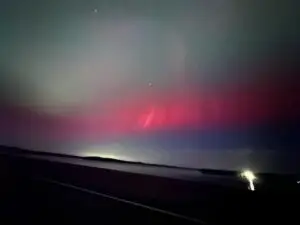 As quickly as it appeared, the aurora faded into the night, leaving behind a sense of wonder and awe in its wake. Yet, its brief visit serves as a reminder that even in the most unexpected places, beauty can be found if we only take the time to look.
As quickly as it appeared, the aurora faded into the night, leaving behind a sense of wonder and awe in its wake. Yet, its brief visit serves as a reminder that even in the most unexpected places, beauty can be found if we only take the time to look.
As Amateur Radio enthusiasts, when looking at current space weather data, pay particular attention to the following: 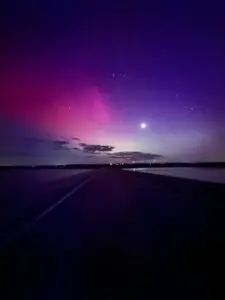
SFI: Solar Flux Index: This number summarizes the sun’s overall level of radiation output. An SFI of 68, for example, is considered low, resulting in poor conditions HF bands,. On the other hand, sn SFI above 200 is high, and the ionosphere will respond by bending more HF signals back to Earth.
K-Index: Solar observatories measure our planet’s magnetic field every 3 hours and translate that result to a number known as the K-index. When the sun isn’t very active the K-index tends to be low, typically around 1 or 2. But as of late the K-index has been averaging 8 to 9 which is considered a major storm that shuts down all HF communications. The higher the K-index, the worse the conditions will be on all HF bands.
A-Index: This represents a daily average of magnetic activity. An A-index between zero and 7 means calm conditions. But if it rises above 40 or 50 you have a geomagnetic storm under way. As of this writing the A-index is above 200 and the K-index is bouncing between 8 and 9. The SFI is 200+.
Where can I find all this information that is up to date? Glad you asked. You can find it right here on the Kilowatt website on the front page. And yes, you’re welcome for that! 🙂
